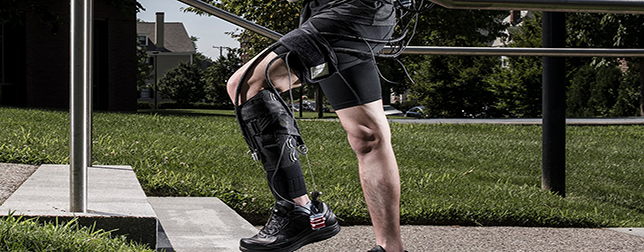Assistive devices like exosuits are being manufactured by various developers including the Harvard Biodesign Lab. In order to make these soft, assistive devices work properly, the wearer and the robot need to be in sync. However, since every human moves in a different style, tailoring a robot to fit the need of an individual user is time consuming and inefficient process.
Now, researchers from the Harvard University have developed an efficient machine learning algorithm that can rapidly tailor personalized control strategies for soft, wearable exosuits, remarkably enhancing the performance of the device.
The research team was led by Conor Walsh, the John L. Loeb Associate Professor of Engineering and Applied Sciences, and Scott Kuindersma, Assistant Professor of Engineering and Computer Science at SEAS.
Read more Designing Exoskeletons to Interact with Humans
“This new method is an effective and fast way to optimize control parameter settings for assistive wearable devices,” said co-first author Ye Ding, a postdoctoral fellow at John A. Paulson School of Engineering and Applied Sciences (SEAS). “Using this method, we achieved a huge improvement in metabolic performance for the wearers of a hip extension assistive device.”
When we walk, we continuously tweak how we move in order to save energy, which in medical term, is known as metabolic cost.

According to Myunghee Kim, another co-first author and postdoctoral research fellow at SEAS, in the past, when three different users were walking with assistive devices, the system called for 3 different assistance strategies, which were very difficult because not only all humans walk differently the experiments required complicated manual tuning.
Read more Myosuit: Wearable Device that Helps Myopathy or Stroke Patients Walk
The researchers developed an algorithm that can penetrate that variability and promptly pinpoint the best control parameters that work best for minimizing the abnormalities of walking.
To adjust the control parameters of the device, the researchers used so-called human-in-the-loop optimization, which uses real-time measurements of human physiological signals like breathing rate. As the algorithm fixated on the best parameters, it instructed the exosuit on when and where to deliver its assistive force to enhance hip extension. The Bayesian Optimization approach used by the team was first reported in a paper last year in PLOSone.
The combination of the algorithm and suit decreased metabolic cost by 17.4% compared to walking without the device. For the team this work provided more than 60% improvement compared to their previous work.
Kuindersma said that optimization and learning algorithms will greatly impact the future wearable robotic devices designed to assist a range of behaviors.
Next, the researchers aim to apply the optimization to a more complex device that assists multiple joints, such as hip and ankle, at the same time.
The research is described in Science Robotics.












